Bass anglers are usually very keen and dedicated to their sport. They’ll drive for miles seeking out new and exciting waterways and will happily camp in remote locations for days on end.
Most own more lures than the average tackle store and rods and reels are usually proudly lined up safely indoors. It’s this sort of commitment and enthusiasm that usually ensures these people consistently run into good numbers of fish.
While it’s great to have all the gear and be able to travel to far-off waterways looking for bass, for many anglers, just catching a few bass locally is considered a victory.
With the warm weather finally upon us, it’s time to start thinking about bass and for many fishos this season will be their first. Hopefully by the time they’ve finished reading this article they’ll have a better understanding of bass and the environment they live in.
And with a little on-water experience, they should be well on their way to consistently catching these great Aussie sport fish.
It’s the catchcry of many a real estate agent, but location is most of the battle when searching for likely bass water. The more remote and clean a waterway, the better the fishing usually is.
It’s often the combination of good water quality and light angling pressure that enables local bass populations to thrive – hence the diehard bassers putting in the effort to find these hidden gems away from the masses.
Having said that, virtually every river and creek system entering the ocean between the Victorian border and Noosa in Queensland is likely to house bass at some point.
Exact fish numbers depend on many things, but usually fish populations rely on good water quality, low angling pressure and water volume. Larger systems with little pressure usually produce the best fishing. Small systems close to urban areas are often the least productive.
Like all good tradespeople, bass anglers have their collection of tools. You need three main things: A rod and reel, lures and a boat, kayak or canoe or at very least a stout pair of snakeproof boots! Oh, and a car to get you to the water.
With a decent light spinning or baitcasting outfit, a good selection of lures and small water craft you have the basics to start looking for bass.
Most keen bass anglers used to believe baitcasting tackle was the only way go when bass fishing. This was largely centred around the belief more accurate casts could be made with such a reel.
Nowadays, light threadline gear is widely accepted as the tackle of choice, with countless anglers proving casting accuracy has more to do with angling ability rather than tackle choice.
If you’re new to casting small lures, threadline gear is the way to go. Look for a 2kg to 4kg spinning rod around 2m long matched with a decent spinning reel around 1500 to 2500 size. Fill the spool mostly with light mono and top-shot with a 100m spool of 6lb braid.
I don’t know any serious bass anglers with a practical amount of lures. Most of my mates have hundreds. But it’s funny how they usually end using only a select few!
To save you suffering the same addiction as my mates, I’ll tell you the select few they usually tie on.
The four main types are surface lures, minnows, bladed lures and soft plastics.
The surface lures usually comprise a mix of poppers, fizzers and bibless sliders, most under 70mm long. A decent mix would include something like Stiffy Poppers, Heddon Torpedos and Stiffy Top Dogs.
Popular minnow choices include Halco Laser Pros and Combats, RMG Scorpions, Tilsan Bass Minnows and Stiffy Fat Boys and Minnows. Just make sure you have an equal mix of deep divers and shallow runners – a longer bib means deeper swimming.
Bladed lures have really proved their worth, especially around the deep rocky pools and for long-range casting in more open areas at night. Their tight, vibrating action really fires up the bass so take a few blades with you. Stiffy Devil Fish, Big River Shake ’ n’ Bakes and TT Switchblades all work well.
For the weed beds and timber, spinnerbaits are pretty hard to beat. There are plenty to choose from so get a few and make sure one has purple in the skirt.
In most waterways a boat, canoe or kayak is a must. There are some smaller creeks where walking the bank is a practical option, but really most bass creeks are best fished from something that floats.
Being on the water, as opposed to beside it, makes life far easier, allowing you unrestricted access to all the likely spots.
You don’t have to worry about sinking in mud, treading on snakes, or not being able to cast because the vegetation is too thick. In most situations, on the water is the only way to go.
If you’ve done any bream spinning, you shouldn’t have too many problems getting comfortable with bass spinning. The same premise of casting to structure and slowly winding applies.
Perhaps the main difference is the lure size and terrain fished.
Bass lures are often twice the size of those used when targeting bream and consequently tend to cast farther and land with more of a splash – often a good thing when bass fishing.
Instead of casting to rock retaining walls, oyster leases, jetties and moored boats, you’ll be flicking lures under overhanging trees, around submerged timber, along the edges of weed beds and tight against natural rock walls and banks.
A good way to think when looking for likely bass spots is to ask yourself ‘would the area hold bait?’ Like all forms of fishing, if there’s no bait holding potential, there’s no real point for fish to be there.
Any tree, rock face or back eddy is likely to hold bait, some just hold more than others. Find the bait and you’ll find the bass.
Bass are aggressive fish and this inbuilt aggression is the bass angler’s best friend. You can play on this by working lures right in the strike zone for long periods.
Say you cast a floating minnow under an overhanging tree. You can let the lure sit there, then bounce the rod tip a few times, making the lure jiggle around right above the fish.
Most bass can’t handle the surface commotion and will usually come up and swipe the lure.
You can use the same approach with surface lures. If the river you’re fishing has any movement, you can use this to your advantage by casting up-current and letting the flow sweep the lure into some very tight country.
Some spots you simply can’t cast into but by using the river it’s surprising where you can drift a lure.
Like most predatory fish, bass often seek out the best ambush positions. This is handy to know because some creeks are wall-to-wall snags and by thinking about which ones are most likely to hold fish, you can save a lot of fruitless casts.
For example, you come to a new pool and both banks are equally deep and snag-ridden. So where should you start?
This depends on a few factors, but often the first deep, undercut snag at the head of the pool will usually hold a few fish.
The secondary spots are those with a little more ‘character’ than the rest. Look for trees that are perhaps collecting more current or have more impressive root systems.
If you work on the idea of bait-holding potential, you’ll begin to work out which snags are probably the most productive.
One other thing about bass: They’re creatures of habit. One fallen tree or deep mid-stream log that produced the goods last trip is just as likely to produce fish again.
After a while you begin to work out where all the productive snags are and during a fairly short afternoon session can bomb all the good spots to great effect.
Seasoned bass anglers have favourite creeks and snags up and down the east coast and when the weather is right, they head off with great expectations.
So once you know the type of country they like and the preferred structure they prefer, consistently catching bass becomes a whole lot easier.
Reads: 3657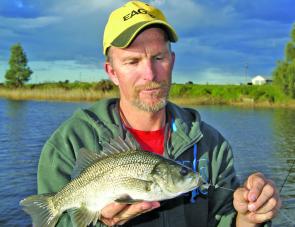
The author with a healthy bass caught taken on a Stiffy Devil Fish blade just above the brackish zone. Fishing deep and slow is a good approach bass, especially when they’re not really fired up.
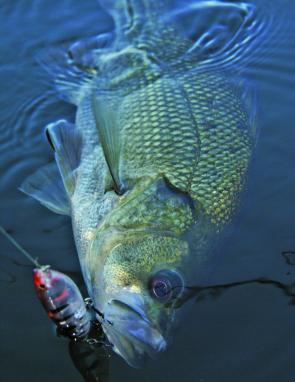
Surface lures and bass go hand in hand. This nice fish took a 90mm Stiffy Top Dog, certainly a sizable lure but not too much challenge for an aggressive bass.
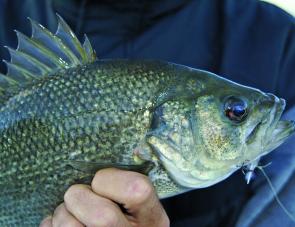
This solid fish came from beneath an overhanging tree – a great place to cast a lure in search of bass.

After dark some big bass often come out to play. Andrew Madden scored this chunky fish on a surface lure.

Stickbaits, like this Stiffy Top Dog, are proving very effective on bass. Results have been great when fishing around timber and along weed beds.

A 60 mm fizzer fooled this nice bass. Andrew caught this on the edge of a weed bed, a great place to look for bass and a top spot to work over with surface lures.

The further you head up-river, often the more pretty the country becomes. It’s not hard to see why keen bass fishers enjoy travelling around looking for great fishing country like this.
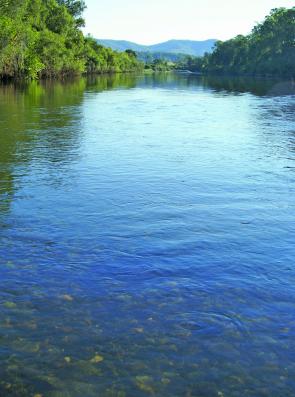
With each new pool comes promise. This lovely pool is a regular producer of quality bass and is perfect for a small boat or canoe.
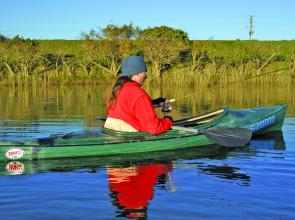
Kayaks and canoes are perfect for bass fishing, opening up country that’s not possible to fish when shore-based.

A tidy little bass taken way up a small feeder creek. Kayaks are great for exploring any streams that branch off the main river.




